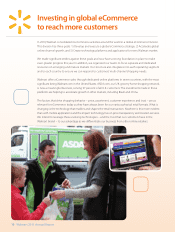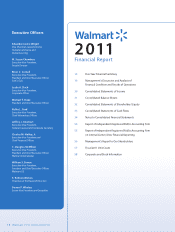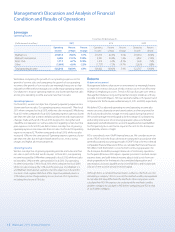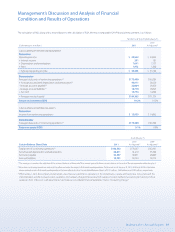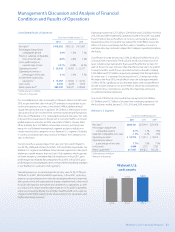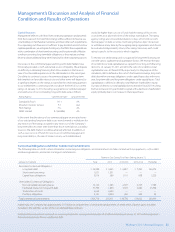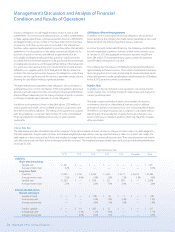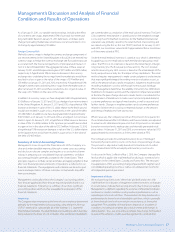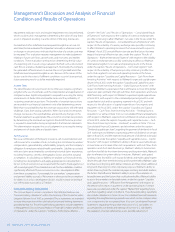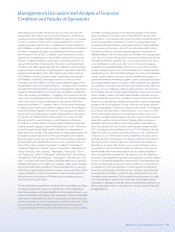Walmart 2011 Annual Report Download - page 22
Download and view the complete annual report
Please find page 22 of the 2011 Walmart annual report below. You can navigate through the pages in the report by either clicking on the pages listed below, or by using the keyword search tool below to find specific information within the annual report.
Management’s Discussion and Analysis of Financial
Condition and Results of Operations
20 Walmart 2011 Annual Report
Free Cash Flow
We dene free cash ow as net cash provided by operating activities in a
period minus payments for property and equipment made in that period.
We generated positive free cash ow of $10.9 billion, $14.1 billion and
$11.6 billion for the years ended January 31, 2011, 2010 and 2009, respectively.
The decline in free cash ow during scal 2011 as compared to scal 2010
is principally due to our increased investment in inventory, partially oset
by an increase in accounts payable. The increase in free cash ow in scal
2010 as compared to scal 2009 resulted primarily from improved operating
results and relatively low inventory levels at January 31, 2010.
Free cash ow is considered a non-GAAP nancial measure. Management
believes, however, that free cash ow, which measures our ability to generate
cash from our business operations, is an important nancial measure for
use in evaluating the Company’s nancial performance. Free cash ow
should be considered in addition to, rather than as a substitute for, income
from continuing operations as a measure of our performance and net
cash provided by operating activities as a measure of our liquidity.
Additionally, our denition of free cash ow is limited, in that it does not
represent residual cash ows available for discretionary expenditures due
to the fact that the measure does not deduct the payments required for
debt service and other contractual obligations or payments made for
business acquisitions. Therefore, we believe it is important to view free
cash ow as a measure that provides supplemental information to our
entire statement of cash ows.
Although other companies report their free cash ow, numerous methods
may exist for calculating a company’s free cash ow. As a result, the method
used by our management to calculate free cash ow may dier from the
methods other companies use to calculate their free cash ow. We urge
you to understand the methods used by another company to calculate
its free cash ow before comparing our free cash ow to that of such
other company.
The following table sets forth a reconciliation of free cash ow, a non-GAAP
nancial measure, to net cash provided by operating activities, a GAAP
measure, which we believe to be the GAAP nancial measure most directly
comparable to free cash ow, as well as information regarding net cash
used in investing activities and net cash used in nancing activities.
Fiscal Years Ended January 31,
(Amounts in millions) 2011 2010 2009
Net cash provided by
operating activities $ 23,643 $ 26,249 $ 23,147
Payments for property
and equipment (12,699) (12,184) (11,499)
Free cash ow $ 10,944 $ 14,065 $ 11,648
Net cash used in
investing activities $(12,193) $(11,620) $(10,742)
Net cash used in
nancing activities $(12,028) $(14,191) $ (9,918)
Results of Operations
The following discussion of our Results of Operations is based on our
continuing operations and excludes any results or discussion of our
discontinued operations.
Certain items that impacted our income from continuing operations
during the scal years ended 2011, 2010 and 2009 were as follows
(in millions):
2011 2010 2009
Credit for certain net tax benets
(1)
$434 $372 $ —
Restructuring charges
(2)
— (260) —
Settlement of wage and hour
class action lawsuits
(3)
— — (382)
(1)
In fiscal 2011, we recorded $434 million in net tax benefits that resulted primarily
from the repatriation of certain non-U.S. earnings that increased U.S. foreign tax
credits and favorable adjustments to transfer pricing agreements.
In fiscal 2010, we recorded $372 million in net tax benefits primarily from the
repatriation of certain non-U.S. earnings that increased U.S. foreign tax credits.
(2)
In fiscal 2010, we announced several organizational changes, including the closure
of 10 Sam’s Clubs, designed to strengthen and streamline our operations. As a result,
we recorded $260 million in pre-tax restructuring charges.
(3)
In fiscal 2009, we settled 63 wage and hour class action lawsuits. As a result of the
settlement, we recorded a pre-tax charge of approximately $382 million during the
fourth quarter of fiscal 2009.
Free cash flow
(dollars in billions)
$10.9
$14.1
$11.6
FY09 FY10 FY11


